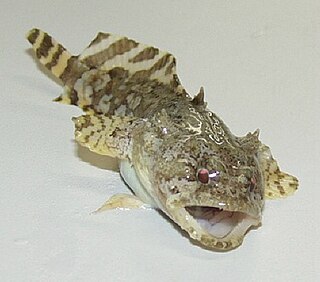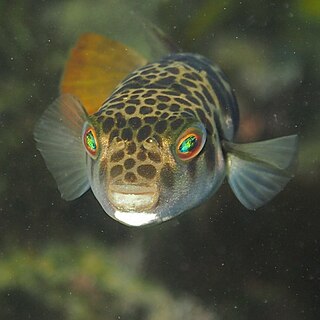
Batrachoididae is the only family in the ray-finned fish order Batrachoidiformes. Members of this family are usually called toadfish or frogfish: both the English common name and scientific name refer to their toad-like appearance.

Corydoras is a genus of freshwater catfish in the family Callichthyidae and subfamily Corydoradinae. The species usually have more restricted areas of endemism than other callichthyids, but the area of distribution of the entire genus almost equals the area of distribution of the family, except for Panama where Corydoras is not present. Corydoras species are distributed in South America where they can be found from the east of the Andes to the Atlantic coast, from Trinidad to the Río de la Plata drainage in northern Argentina. Species assigned to Corydoras display a broad diversity of body shapes and coloration. Corydoras are small fish, ranging from 2.5 to 12 cm in SL., and are protected from predators by their body armor and by their sharp, typically venomous spines.

A midshipman fish is any species of toadfish belonging to the genus Porichthys. Historically, there have been two common names. Porichthys refers to the well developed pores on the fish, and this led to the common name "Porous Catfish". The other common name, "Midshipman" is based on the pattern of button-like luminous spots (photophores) which resemble the buttons on the uniforms of young naval officers known as Midshipmen.

Venomous fish are species of fish which produce strong mixtures of toxins harmful to humans which they deliberately deliver by means of a bite, sting, or stab, resulting in an envenomation. As a contrast, poisonous fish also produce a strong toxin, but they do not bite, sting, or stab to deliver the toxin, instead being poisonous to eat because the human digestive system does not destroy the toxin they contain in their bodies. Venomous fish do not necessarily cause poisoning if they are eaten, as the digestive system often destroys the venom.

Rineloricaria is a genus of freshwater tropical catfish belonging to the family Loricariidae. They are commonly called whiptail catfish because of the long filament that grows out of the tip of the caudal fin that is characteristic of the genus. With the exception of R. altipinnis from Panama, they are native to the rivers of northern and central South America. Some species are regularly seen in the aquarium trade.

Steindachneridion is a genus of South American pimelodid catfish.
Harttia is a genus of armored catfishes native to South America.

Pristobrycon is a genus of piranhas from the Orinoco and Amazon Basins, as well as rivers in the Guianas.

Batrachoides is a genus of toadfishes.

Tetraroginae is a subfamily of marine ray-finned fishes, commonly known as waspfishes or sailback scorpionfishes, belonging to the family Scorpaenidae, the scorpionfishes and their relatives. These fishes are native to the Indian Ocean and the West Pacific. As their name suggests, waspfishes are often venomous; having poison glands on their spines. They are bottom-dwelling fish, living at depths to 300 metres (980 ft). These creatures usually live in hiding places on the sea bottom.
Sternarchogiton is a genus of weakly electric knifefish in the family Apteronotidae, with four known species, all living in the main channel of large rivers in the Amazon and Orinoco basins in South America.

The smooth toadfish is a species of fish in the pufferfish family Tetraodontidae. It is native to shallow coastal and estuarine waters of southeastern Australia, where it is widespread and abundant. French naturalist Christophe-Paulin de La Poix de Fréminville described the species in 1813, though early records confused it with its close relative, the common toadfish. The two are the only members of the genus Tetractenos after going through several taxonomic changes since discovery.
Sternarchella, the bulldog knifefish, is a genus of ghost knifefishes found at depths of 2–50 m (7–164 ft) in the main channel of large rivers in South America. Most are from the Amazon basin, but S. orthos is found both in the Amazon and Orinoco, S. orinoco is restricted to the Orinoco and S. curvioperculata restricted to the upper Paraná basin. They are often common in their habitat.

Apionichthys is a genus of mostly freshwater American soles native to South America.

Bothragonus is a genus of marine ray-finned fishes belonging to the family Agonidae, the poachers and related fishes. It is the only genus in monotypic subfamily Bothragoninae. These fishes are found in the northern Pacific Ocean.

The dwarf flathead is a species of marine ray-finned fish belonging to the family Platycephalidae, the flatheads. It is found in the Indo-Pacific. It is the only species in the monotypic genus Elates.

Cottoperca is a genus of marine ray-finned fishes belonging to the family Bovichtidae, the temperate icefishes or thornfishes. They are found in the southeastern Pacific, southwestern Atlantic and northern Southern Oceans off southern South America.

Thalassophryninae is a subfamily of toadfish in the family Batrachoididae. The species in the subfamily are characterised by the possession of two dorsal fin spines, a lack of subopercular spines, with the dorsal and opercular spines being hollow and have venom glands at their base. They do not have canine teeth.

Thalassophryne maculosa, the Cano toadfish, is a species of toadfish which is common along the Caribbean coasts of South America from Colombia to Trinidad and Venezuela. It occurs on the sandy bottoms of reef flats, lagoons, and seaward edges of reefs where it sits partially buried in the substrate. It is a venomous species with the venom being delivered through spines and wounds from the spines have been known to cause severe symptoms of pain and illness that may persist for up to a week. A study of the holotype of Batrachus uranoscopus, said to be a freshwater toadfish from Madagascar, in the Muséum national d’Histoire Naturelle in Paris found that it was most probably a misslabelled specimen of Thalassophryne maculosa and that subsequent records of Batrachus uranoscopus were attributable to Allenbatrachus meridionalis, a species found in Madagascar. T. maculosa is the type species of the genus Thalassophryne, the generic name translates from Greek as "sea toad" while the specific name is Latin for "spotted".

Scorpaena jacksoniensis, the Eastern red scorpionfish, Billy Bougain, cardinal scorpionfish, coral cod, coral perch, Eastern red scorpioncod, fire cod, Northern scorpionfish, ocean perch, prickly heat, red rockcod or red scorpion-cod, is a species of marine ray-finned fish belonging to the family Scorpaenidae, the scorpionfishes. It is found in the south western Pacific Ocean.

















